Paul Rogers may go far, all the way to central Europe from his northern Utah home, but he’s never far from his muse. After all, aspens are among the world’s most widespread tree.
This month in Czechia, aspens were indeed Rogers’ focus — as they have been for other scholarly retreats over his 20-plus years of research. Rogers is director of Utah State University’s Western Aspen Alliance, an informational clearinghouse for the tree garnering admiration every fall.
For the start of the shimmering show in the American West, Rogers found himself abroad, studying a species different from the “quaking” one known here. But many things were the same.
For one: “I never meet anyone, public or professional, who doesn’t say this is their favorite tree,” Rogers said in a Zoom call. “You know, for centuries, both in this continent where I’m sitting and where you’re sitting, people have gone to aspen forests for meditative or healing purposes.”
For the leading expert, it was as good a time as any to ruminate on the subject inspiring Colorado road trips and hikes in the days and weeks ahead.
They’ll see golden groves as beautiful, just as Rogers sees them. But he sees them as much more than that.

Aspens dwarf a photographer as he looks for his next photograph on Kelber Pass near Crested Butte, Colo., Sunday, Oct. 6, 2019. (The Gazette, Christian Murdock)
Rogers is a biogeographer, “which is a fancy way of saying I’m interested in where plants are and why they are there,” he says. “And I’m particularly interested in human impacts. How are humans changing their arrangement?”
Of particular interest has been Pando, the famed aspen colony spanning Utah’s Fishlake National Forest. Its diminishing ranks have been documented — largely, Rogers has said, due to deer and cattle munching on young trees before they grow. Pando, like aspen clones everywhere, duplicates members of a grove, the system of roots an underground life source sending up new member trees.
“It’s worked great for a long time,” Rogers said, hundreds or potentially thousands of years. “But now we’ve rapidly changed the scene. We took away predators and have lots of herbivores, and herbivores are protected because hunting is not allowed there, because people are around.”
And this is a noted threat to aspens beyond. A human-created threat, Rogers has said, along with climate change.
Scientists are only beginning to understand where aspens fit into Earth’s sixth and ongoing extinction-level event. From Rogers’ view, “climate change is sort of this cliff,” he said, gesturing to the end of his table. “How do we slow down our movements toward that system collapse?”
It’s another analogy he uses. “Maybe I’m full of analogies,” he said. Maybe, he thinks, those can help more people better understand.
“Ultimately, we sort of have an ecologically illiterate society,” Rogers said, “and issues like climate change, it’s kind of dangerous that our average citizens don’t know how the world functions and how we connect to it.”
Aspens, he said, are a helpful microcosm. A small part of the big picture, but a big player in biodiversity.

The turning aspens on Kebler Pass near Crested butte show a full palette of colors on Oct. 6, 2019.
They are central to the next-most biodiverse ecosystem in the Rocky Mountain West after the riparian forest, fostering a vast, colorful world. It’s believed more than 100 plants can live under an aspen stand, attracting a host of bugs, birds and mammals big and small.
“We know that diverse systems are more resilient than mono systems,” Rogers said. “Think of a corn field vs. a very diverse forest. If we’re all the same, one disease comes along — say COVID — and it could wipe us out pretty quick if we were genetically identical. Good thing we’re not.”
Good thing aspens are not. Though, clone families are genetically the same. Trees from the same root system share physical traits: Bark color and leaf shape are different clone to clone, grove to grove. Their numbers are different, one clone accounting for a few trees and another a few hundred. Their ability to fend against disease and other threats is different.
But all are the same for how they function, how the roots carry water and how energy is stored and lost throughout the seasons, how leaves alternate between summertime green and that beloved gold.

Fallen aspen leaves litter the ground near Victor on Thursday, Sept. 13, 2012.
Aspens are different and the same, connected by that underground life source.
“It’s kind of cool to bridge that to social-cultural situations,” Rogers said. “We’re more connected than we think. We need each other more than we think.”


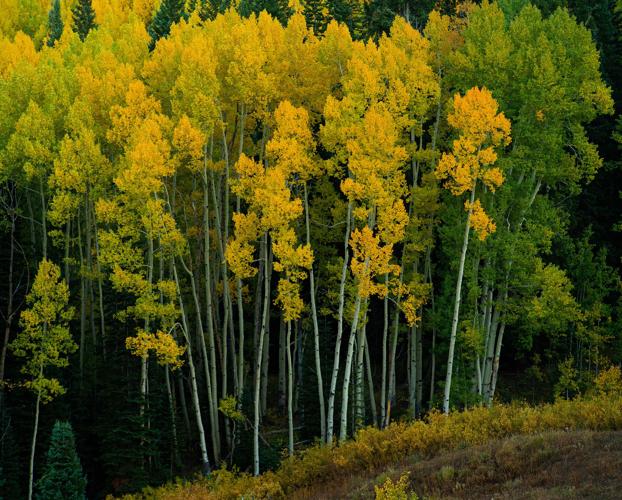




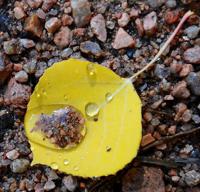

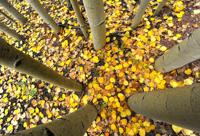



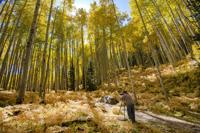

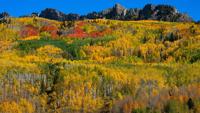


 Your Privacy Choices
Your Privacy Choices